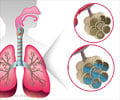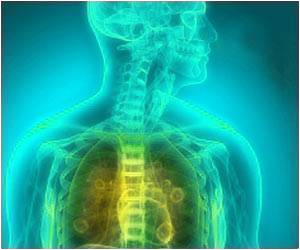- A gene therapy approach has been developed for treating pulmonary edema
- It is mediated through the delivery of specific genes into lung tissues
- Gene delivery significantly reduces the leakiness of the lung membranes
- This prevents the worsening of the symptoms of pulmonary edema
Read More..
Study Team
The study was led by Dr. Donald E. Ingber, MD, PhD, who is the Founding Director of the Wyss Institute for Biologically Inspired Engineering and also the Judah Folkman Professor of Vascular Biology at Harvard Medical School and the Vascular Biology Program at Boston Children’s Hospital (BCH), and Professor of Bioengineering at Harvard’s John A. Paulson School of Engineering and Applied Sciences, Cambridge, Massachusetts, USA.Dr. Ratnakar Potla, MBBS, PhD, is a co-author of the paper. He was previously a Research Fellow in the Vascular Biology Program at BCH and is currently at the Wyss Institute for Biologically Inspired Engineering, Harvard University, Boston, Massachusetts, USA.
Dr. Rachelle Prantil-Baun, PhD, is another co-author of the paper. She is a Senior Staff Scientist at the Wyss Institute for Biologically Inspired Engineering, Harvard University, Boston, Massachusetts, USA.
Pulmonary Edema Lacks Specific Targeted Therapies
Pulmonary edema is the leaking of fluid from the blood capillaries surrounding the lungs into the air sacs or alveoli, where the exchange of oxygen and carbon dioxide takes place during respiration. Pulmonary edema develops in approximately 80 percent of heart failure patients. In this condition, oxygen uptake by the lungs is severely hindered, resulting in difficulty in performing everyday tasks and in severe cases, can be life-threatening.Importantly, there are currently no drugs that directly treat the complications of pulmonary edema. Those drugs that are available treat the condition indirectly by lowering the blood pressure and reducing the total fluid content of the body, in a bid to reduce the damage that has been caused.
“Pulmonary edema is similar to a leak in a water pipe. The most effective thing to do is to plug the leak, but current drugs on the market work to shut off the water supply altogether and hope the leak fixes by itself,” says Potla. “With our method, we can actually target the leak, which is a much more efficient way to address the problem.”
Mechanism of Pathogenesis of Pulmonary Edema
The mechanism of pathogenesis of pulmonary edema was deciphered by studying a specific channel protein called TRPV4 (Transient Receptor Potential Cation Channel Subfamily V Member 4). This TRPV4 protein, encoded by the TRPV4 gene, is a non-selective cation channel present in lung cell membranes. The TRPV4 protein is activated by mechanical stress that occurs when the lungs inflate and deflate during breathing. TRPV4 is involved in the regulation of the flow of substances, including cations such as calcium ions, between the blood capillaries of the lungs and the alveoli. Activation of TRPV4 causes the lung tissues to become ‘leaky’, resulting in accumulation of fluid in the alveoli, thereby progressively worsening the pulmonary edema.Problems of Current Drug Therapies for Pulmonary Edema
Targeted therapies for pulmonary edema are currently lacking. A drug that has been developed by GlaxoSmithKline (GSK) inhibits TRPV4 by chemically blocking the channel. This drug is currently undergoing Phase III clinical trials. However, inhibiting TRPV4 is problematic, as this channel protein is involved in numerous other physiological processes, including bone remodeling and maintaining the urinary bladder tone. Therefore, inhibition of TRPV4 gives rise to many unwanted side effects that limit its utility as a drug target.How Did the Research Team Overcome the Problems?
The Wyss and BCH researchers attempted to overcome the problems by shifting their attention from TRPV4 to another membrane protein called CD98hc. This protein transmits mechanical forces to the TRPV4 channel. The research team found that overexpression of the high homology (HH) domain of the CD98hc protein blocked the mechanical activation of TRPV4. Thus, the researchers opined that delivering the HH domain of CD98hc to lung cells by means of gene therapy, could prevent the leakage of fluid from the lung capillaries, thereby halting the progression of pulmonary edema. Importantly, the researchers hypothesized that this could act as a specific targeted therapy for treating pulmonary edema.Gene Therapy Studies
In order to confirm their hypothesis, the researchers developed recombinant gene constructs using AAV vectors derived from various serotypes of the virus. The specific DNA (deoxyribonucleic acid) encoding the HH domain of the CD98hc protein was cloned into these AAV vectors for gene delivery. The efficiency of gene transfer was tested by transfecting human Pulmonary Alveolar Epithelial Cells (PAEpiC) and primary Human Pulmonary Microvascular Endothelial Cells (HPMEC) with the viral gene constructs. These cells were chosen for the gene delivery experiments as they are situated at the interface between the alveoli and the blood capillaries of the lungs and therefore play a crucial role in the development of pulmonary edema.Of the different AAV vectors that were tested, the researchers found that AAV2.5T was the most efficient in driving gene expression in both cell types – epithelial and endothelial. Importantly, the cells in which the HH domain-encoding gene was expressed were capable of completely inhibiting the mechanically-activated calcium signaling pathway mediated through TRPV4. Moreover, a drug that stimulated TRPV4 restored the activity of the calcium signaling pathway. This confirmed that gene therapy was capable of specifically blocking TRPV4’s mechanically-activated calcium signaling pathway, leaving its other functionalities unaltered.
Lung Alveolus Chip Studies
Lung Alveolus Chip is a clinically relevant human lung model developed by Wyss Institute scientists. This chip was used to evaluate the efficiency of gene delivery and the overexpression of the HH domain of CD98hc.The microfluidic Lung Alveolus Chip consists of two narrow compartments separated by a permeable membrane. One side of this membrane is lined with PAEpiC and the other with HPMEC. The PAEpiC side is perfused with air, while the HPMEC side is perfused with fluid. The motion of the lungs that occur during breathing was simulated by alternate stretching and relaxing of the membrane using a suction device.
It was observed that when the air compartment of the chip was filled with fluid for four hours to simulate pulmonary edema, the membrane partition between the air and fluid compartments became compromised, and recovery was not possible even after removal of the fluid.
However, following gene delivery into the Lung Alveolus Chip, fluid leakage into the air compartment was significantly reduced, and the cells lining the membrane remained intact, even under mechanical stress, mimicking the motion of the lungs during breathing.
“Remarkably, we saw a significant improvement in lung function even though only about 30 percent of the lung epithelial cells and 10 percent of the vascular endothelial cells were successfully transfected with the gene coding for the HH domain of CD98hc, indicating that this strategy is extremely protective,” says Prantil-Baun.
Future Plans
The researchers are optimistic that the findings of the present study could pave the way towards the development of mechanotherapeutic drugs for targeted gene therapy for treating pulmonary edema.Concluding Remarks
Ingber concludes: “This is one of the first examples of how the mechanical signaling activity of a transmembrane molecule that is sensitive to both physical forces and chemical cues can be selectively targeted with a tailored mechanotherapeutic to provide a more specific therapeutic response. We hope there will be many more to follow.”Funding Source
The study was supported by grants from the National Institutes of Health (NIH), Bethesda, Maryland, USA.References:
- AAV-mediated Gene Therapy Targeting TRPV4 Mechanotransduction for Inhibition of Pulmonary Vascular Leakage - (https://aip.scitation.org/doi/10.1063/1.5122967)
- A lifeline for leaky lung cells - (https://wyss.harvard.edu/news/a-lifeline-for-leaky-lung-cells/)
Source-Medindia















